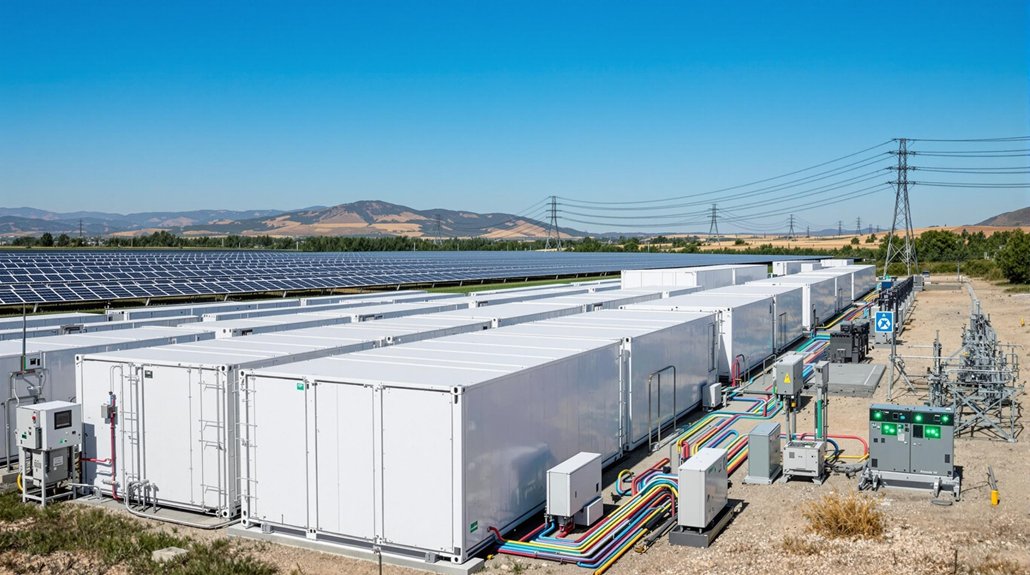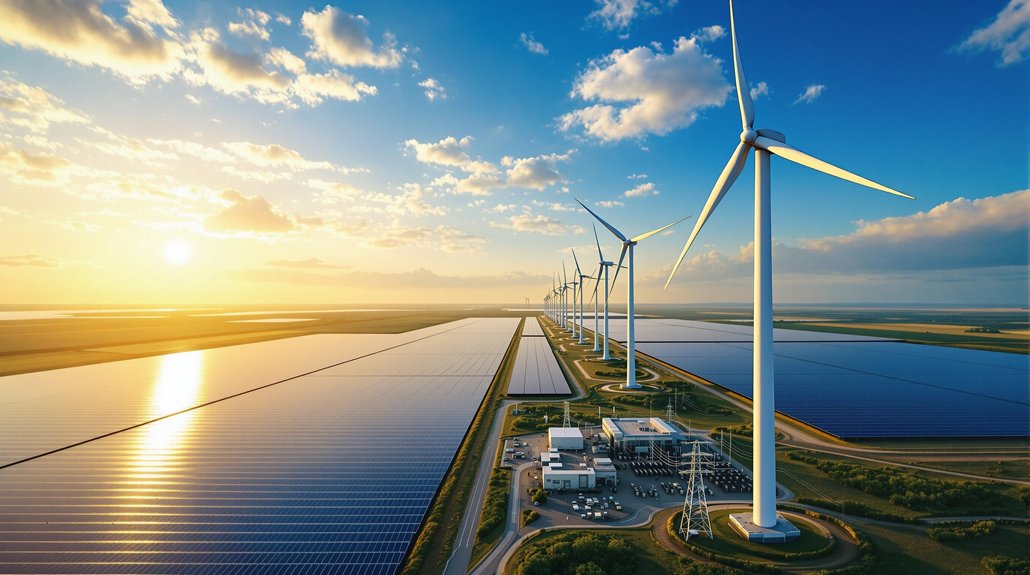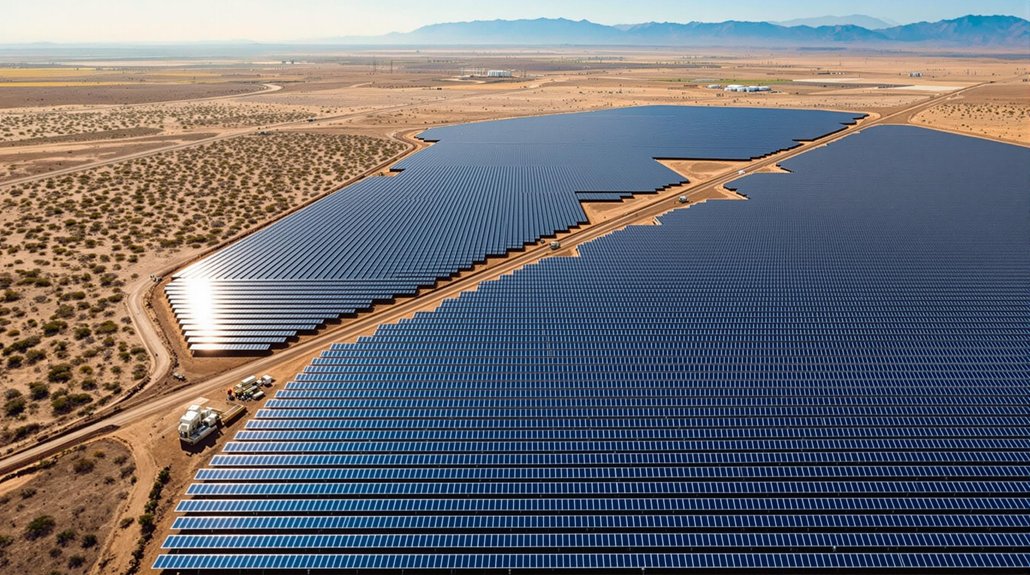Energy storage systems work like giant rechargeable batteries for the power grid. They capture electricity when it’s plentiful and release it when needed. During charging, electricity flows from the grid or renewable sources into battery modules. The system converts AC power to DC for storage. When power is needed, the process reverses, sending electricity back to the grid. These systems help integrate renewables and provide backup during outages. The technology offers solutions beyond just storing energy.

Most modern energy storage systems work like giant rechargeable batteries for the power grid. These systems capture electricity when it’s abundant and release it later when it’s needed. They consist of several key parts that work together. Battery modules store the electrical energy, while a power conversion system changes electricity between AC and DC forms. A battery management system keeps an eye on the batteries to guarantee they’re working safely. An energy management system makes decisions about when to charge or discharge, and thermal management keeps everything at the right temperature. BESS technology offers significant commercial value due to its fast-response supply capabilities during peak demand periods.
The charging process begins when electricity flows in from the grid or renewable sources like solar panels. The power conversion system changes this electricity from AC to DC so it can be stored in the batteries. As the batteries charge, they store the energy as chemical potential. The battery management system controls how fast this happens, while thermal management prevents the batteries from getting too hot during charging.
Electricity enters, transforms from AC to DC, and becomes chemical potential under careful management of temperature and charge rate.
When power is needed, the energy management system signals that it’s time to discharge. The battery management system activates the discharge process, and the chemical energy in the batteries changes back to electrical energy. The power conversion system then converts the DC electricity back to AC so it can power homes and businesses. Communication systems facilitate the information exchange between all components to ensure smooth operation of the entire system.
There are several types of energy storage technologies. Lithium-ion batteries are most common today, but other options include pumped hydro storage, compressed air systems, flywheels, and thermal storage. Each works differently but serves the same purpose of storing energy for later use.
Energy storage systems have many uses. They help integrate solar and wind power into the grid, provide backup power during outages, reduce peak electricity demand, support grid stability, and allow users to buy electricity when it’s cheap and use it when prices are high. BESS are highly adaptable and can be integrated into various environments including utility-scale applications and residential settings.
Despite challenges like high costs and limited duration, energy storage is becoming an essential part of our modern electrical system.
Frequently Asked Questions
What Is the Lifespan of Different Energy Storage Systems?
Energy storage systems vary greatly in lifespan.
Lithium-ion batteries typically last 10-15 years with 1-2% annual capacity loss.
Flow batteries can function for 20-30 years with minimal degradation.
Pumped hydro storage offers the longest lifespan at 50-100 years with proper maintenance.
Compressed air energy storage systems operate for 20-40 years.
Temperature, charging patterns, and regular maintenance greatly affect how long these systems remain functional.
How Much Does Energy Storage Installation Typically Cost?
Energy storage installation costs typically range from $12,000 to $20,000 for home systems.
Brand-specific pricing varies greatly: Tesla Powerwall 3 costs $9,300 for 13.5 kWh capacity, while Enphase IQ Battery 5P runs $3,000-$5,000 for 4.96 kWh.
Commercial systems cost $400-$750 per kWh.
Total expenses include equipment (50-60%), labor (30-40%), and permitting (5-10%).
The 30% federal tax credit helps reduce overall costs.
Are There Environmental Concerns With Battery Storage Systems?
Battery storage systems raise several environmental concerns.
Mining lithium and cobalt damages habitats and uses excessive water. Manufacturing creates carbon emissions and involves toxic chemicals.
Only 5% of lithium-ion batteries are recycled globally, with most ending up in landfills. Improper disposal can leak hazardous materials into soil and water.
During operation, batteries risk fires that release toxic fumes and may disrupt local ecosystems.
Can Energy Storage Systems Power My Entire Home?
Energy storage systems can power entire homes, but with limitations.
Standard 5-20 kWh systems can run essential appliances for 6-10 hours, while larger 20 kWh units might power an entire home for a day.
Most systems aren’t designed for complete home backup. Running HVAC and large appliances requires bigger systems.
For extended outages, homeowners often combine battery storage with solar panels or generators.
Which Storage Technology Has the Highest Energy Efficiency?
Based on the provided data, lithium-ion batteries and flywheels share the highest energy efficiency rating at 85-95% round-trip efficiency.
Both technologies can return most of the energy put into them. While they’re equally efficient, they serve different purposes.
Lithium-ion batteries work well in electric vehicles and grid storage, while flywheels excel in applications requiring quick response times and frequent cycling.









